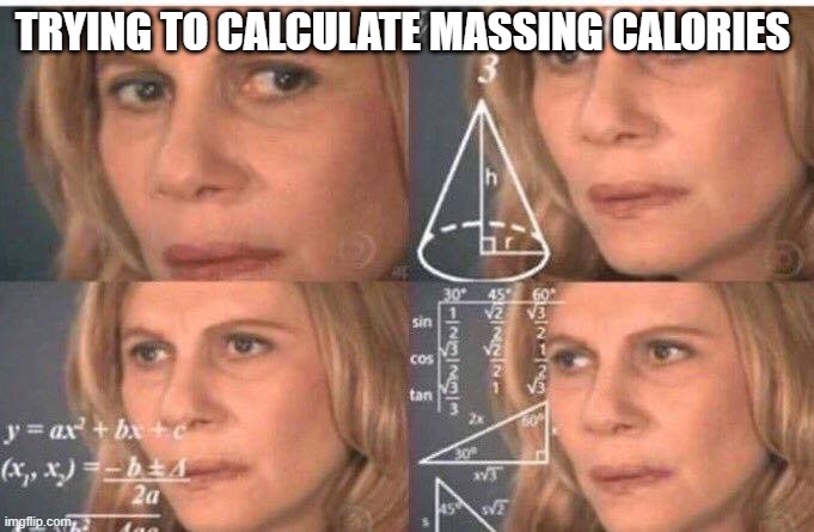Today’s guest post comes courtesy of United Kingdom based strength & nutrition coach, Harry Archer.
Harry wrote a popular article for the site a few weeks ago titled Why Tony’s Pecs Can Cut Diamonds Why Gym Bros Should Periodize Their Nutrition that you can check out HERE.
He’s back with another edition of “Gym Bros Nutrition,” this time going into the weeds on caloric intake when attempting to put on muscle.
It’s good.
Enjoy!

Math For Gym Bros: How to Set Up Calories For a Mass Gaining Phase
So you’ve decided to get jacked.
You, my friend, have made a very very excellent decision because let’s face it – being jacked is awesome.
Filling out T-shirts from the Traps/Shoulders/Chest down instead of gut-up, walking sideways through doors and generally having massive biceps – being Yoked is an awesome feeling.
Before you start eating everything in sight for the gains there’s a few things we need to go over to help you optimize your Massing phase.

Important things, like what to focus on to maximize your hypertrophic potentiation during your deliberate hyper-caloric overfeeding stage, and using individualized nutrition protocols to accrue muscle protein synthesis at a maximal rate of gain whilst preventing muscle protein breakdown and attenuating increases in adiposity.
Stuff like that.
How Many Calories?

You might have heard before that total calories are the most important variable for slabbing on some size.
It certainly helps, but total protein intake is actually the real MVP.
“Once individual protein requirements are met, energy content of the diet has the largest effect on body composition” – Rozenek et al, 2002.
See inadequate calorie intake doesn’t actually undermine muscle gain if protein is adequate. You can still gain size if your protein intake is on point EVEN IF you’re not eating enough calories (although this is less ideal)
Gaining muscle comes to the relationship between Muscle Protein Synthesis (MPS) vs Muscle Protein Breakdown (MPB). MPS is the process of building our muscle tissue, MPB is the process of breakdown muscle tissue.
Think of it like this:
- MPS = good for gains
- MPB = bad for gains
We wanna promote the muscle building process (MPS) and fend off breaking down muscle tissue as much as possible.
We can do this two ways:
- Stimulate the shit out of Muscle Protein Synthesis via lifting weights
- Stimulate MPS by eating enough Protein – namely, Leucine – often enough
Lifting weights is a pertinent stimulus for muscle protein synthesis. So let’s assume you’ve got training to a T – you’re doing all the big lifts, hitting that sweet progressive overload each week/month and generally being a badass.
(If you’re not, you really need to do something about that…HERE)
As your lifting is taken care of we need to look at stimulating MPS via your protein intake.
Muscle Protein Synthesis occurs on a cycle throughout your day:
- You’ll stimulate it (by training & eating Protein)
- You’ll get a “Muscle Full” effect after 1-2 hours
- You’ll hit our Refractory Period after approx 2 hours
- You’d then stimulate it again (by eating Protein)
So as you’re trying to keep MPS stimulated, and prevent gains catabolism, you need frequent protein feedings to keep MPS stimulated. You can do this by eating enough protein every 3-4 hours.
So What’s Enough Protein?

To optimize muscle gains we’re looking to create what’s called a “Muscle Full Effect” – this is where there’s enough protein to saturate the muscle tissue which helps it grow bigger.
Like all good things anabolism only lasts a short-time so we need to constantly stimulate it.
Now, you might be thinking “yeah but Harry, what if there’s still amino acids leftover, from our previous protein intake, can’t my body just use those to keep stimulating MPS for all eternity?”.
You’d think that would be a groovy thing to do, but unfortunately, it doesn’t work like that dude. We need a constant supply of Leucine and nitrogen to keep synthesizing new muscle tissue.
So Give Me Like A Number Of PrOtEiNz To Eat
- – REGULAR servings of protein — 4-6 “feeds” per day
- – Meals 2-4 x 0.4-0.5g/kg (do the math = bodyweight in kg x 0.4 or 0.5)
- – Post-exercise recovery shake 1-2 scoops
- – Large Bolus before bed
So if you’re 80kg (<— Note from TG: ~175 lbs for us Americans)
You can realistically eat three meals per day, with a shake post-workout and a bolus before bed:
- 3 Meals of 0.4g/kg protein per meal = 0.4 x 80 x 3 = 100 (rounded)
- 2 Scoops PWO shake = 35g (+100)
- 1 Large Bolus = 30-40g (+135g)
= 165-175g protein per day, spread evenly throughout the day (as above).
Calories, FTW

Once protein intake is sorted, it’s ideal if we’re eating in a calorie surplus.
WTF is a calorie surplus?
A calorie surplus is the principle of consuming a certain amount of calories above your maintenance calories.
See, a calorie surplus is what huge biceps are for Instagram likes – the most important thing ever.
This is a period of deliberate overfeeding of our body (aka Massing or Bulking or Getting Swole), coupled with resistance training, in order to optimally synthesize muscle tissue growth.
Whyyyyyyyy?
‘Cos it’s the best chance you have of off-setting muscle protein breakdown of course.
A surplus is one of the most effective ways to off-set muscle protein breakdown because you literally have enough calories to make sure muscle protein breakdown doesn’t happen.
Eating above your maintenance caloric intake is how you’re going to get the most out of your time building muscle mass.
I mean sure, whilst you could build lean muscle tissue in a deficit (eating less than you expend), or in maintenance (maintaining bodyweight), you’re just going to build more mass, quicker, AND have a higher overall potential growth rate if you eat in a mild surplus.
Which is the goal right?
Synthesize as much new muscle tissue (whilst keeping fat gain to a relative minimum preferably) as your body will allow you to.
Calculating the Gains

To grow new muscle tissue it’s best practice to eat in a surplus.
How many calories do you need for a surplus?
How To Calculate Your Massing Calories
Step 1: Figuring Out Your Maintenance Calories
I use a simple formula, courtesy of Martin MacDonald:
- 24 x body-weight in kilograms (bw/kg) = Maintenance
Men expend approximately 1 calorie per kilogram of bodyweight per hour (24 hours in a day)
Step 2: Figuring Out Activity Level Demands:
- Sedentary (little or no exercise) Maintenance x 1.15
- Mostly Sedentary (office work + 3-6 days of lifting) Maintenance x 1.35
- Lightly Active (Active job + 3-6 days of lifting) Maintenance x 1.55
- Highly Active (Super Active job + 3-6 days of lifting) Maintenance x 1.75
This gives you an idea of how your activity level influences your maintenance weight.
*MAC Method for Calculating Energy Intake, Martin MacDonald.
Adding In Mass Phase Calories
Now we’d need to add in a surplus.
This will depend where you’re at as to what kind of surplus is necessary for you to start bulking on. All listed are calculated based on monthly bodyweight gains.
- New lifter = 2% per month (>6 month of lifting)
- Novice = 1.5% (Progresses training loads weekly)
- Intermediate = 1% (Progresses training loads monthly)
- Advanced = 0.5% (Progresses over multiple months/years)
To calculate growth rates:
- Target Rate of Gain: Recommended (as above) * Body-weight in KG
- g. Intermediate Lifter, 80kg bw x 1% = 0.8kg per month
(Bear in mind, it takes approximately 2500 calories to gain 0.45kg muscle tissue (1lb) and we’d be looking at that over a month).
Putting It Together
Let’s say you weigh 80kg (or 175 lb for the ONLY country in the galaxy that doesn’t use the metric system).
You’re an intermediate lifter, you’ve been lifting 5x per week in your home gym, but you’ve got a sedentary job due to being sat on your ass on Zoom now because a global pandemic forced you to work from home.
To figure out your Surplus Calories:
Step 1: Maintenance Calories = 24 * 80 (bw/kg) = 1920
Step 2: Activity Multiplier = 1920 x 1.35 (activity level) = 2592
Step 3a: Calculate Surplus (1%) = 80kg * 1% (0.01) = 0.8kg per month (0.8/0.45 = 1.7 * 2500 = 4250 additional calories per month)
Step 3b: Calculate Daily Surplus = 4250 (additional calories per month) / 30 (average days in month) = 141 cals
Step 4: Add It All Together:
- Maintenance (1920),
- *Activity Level (35) = 2592
- + Desired Surplus (141)
= 2733 Calories per day
Brain hurt yet?

Here’s the fun(ner) part:
Calculating Protein Intake:
You’d take off your protein intake from your calorie Range:
Step 1: 176 (from example above) x 4 (4 cals/g Protein) = 704 calories
Step 2: Daily Calories (2637) – Protein Calories (704) = 1933 (to split between fats/carbs)
Calculating Carbs and Fats:
Fats are typically set at: 15-40%
Carbs are set at: whatever’s left
Step 1: Set Fat Intake: 0.30% * Total Calories = 791
Step 1b: 791/9 (9cals/g Fat) = 87g
Step 2: Protein Calories + Fat Calories = 704 + 791 = 1495
Step 3: Total Calories – Protein + Fat Calories = 2637 – 1495 = 1142/4 (4 cals/g Carbs)
Step 4: Carbohydrate Calories = 285g (what’s left after you’ve accounted for Protein + Fat)
So all putting that altogether, you’d start with:
- Calories: 2796
- Protein: 176g
- Carbs: 285g
- Fats: 87g
This is based on recommendations for protein intake, maintenance calories, activity level and surplus based on desired rate of gains.
It’s worth mentioning that initial calculations are….guidelines.
Energy balance is fluid, as our energy intake and expenditure usually fluctuates every day, however, it’s a useful starting point.
We’d usually monitor progress variables and make changes off of that data anyway.
So figure out what you need using the step by step formula (or have someone do it for you), and track bodyweight changes over the month so see how you’re getting on vs desired rates of gains.
You can change and adjust every 2-4 weeks, depending on growth rates/activity level.
About the Author
Harry Archer is a Strength and Nutrition Coach based in Bedford, UK.
Having worked in the fitness industry for nearly a decade, he’s worked in commercial gyms, private gyms, performance gyms, health clinics and more recently online (thanks COVID), with a variety of clients, ranging from helping the John’s from Project Management get Jacked With Abs, to coaching Strength-Sport performance athletes attempting World Records.
He’s usually happiest when lifting and eating, and when thinking about lifting and eating. Follow him on his Insta HERE.











